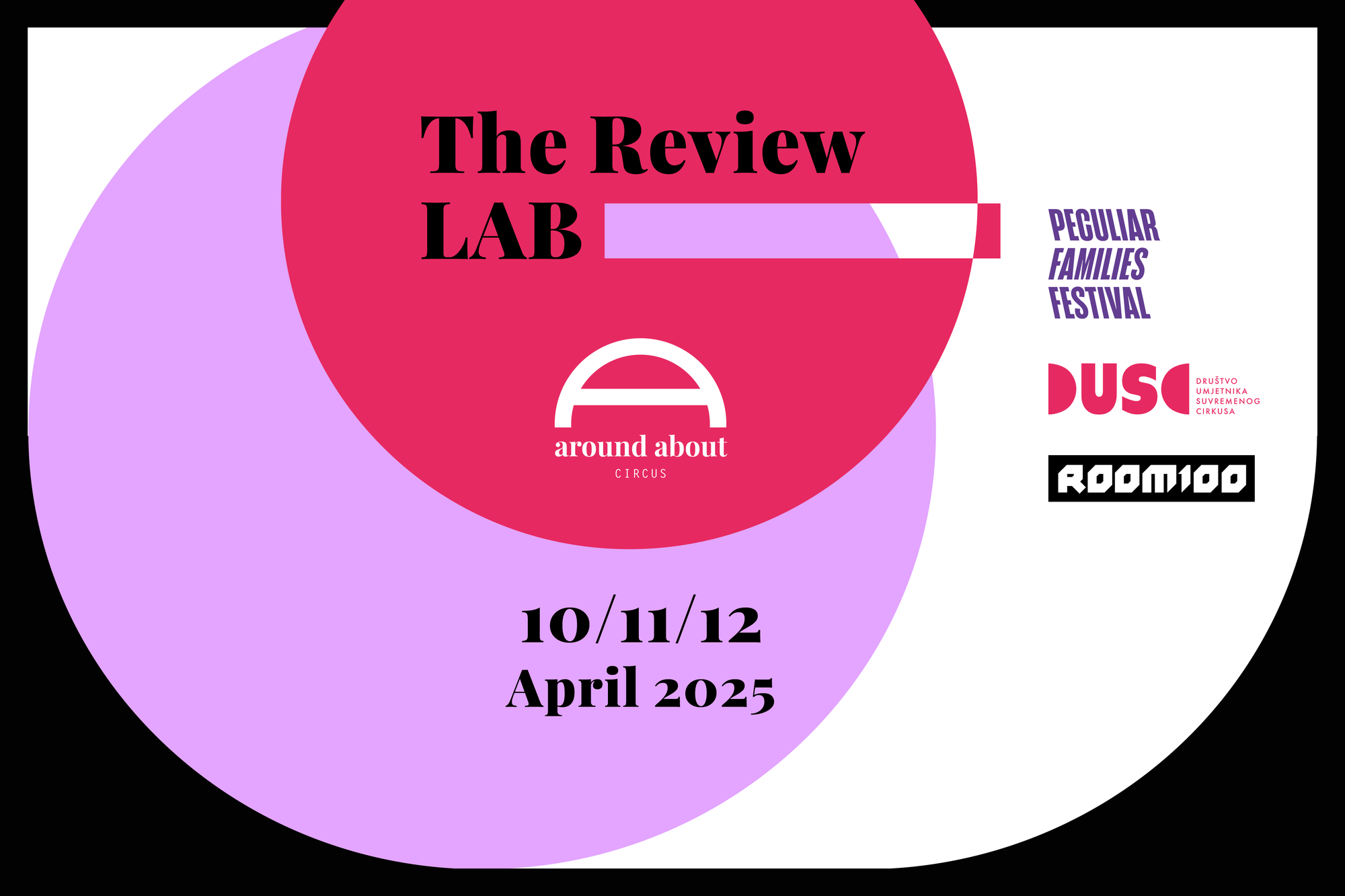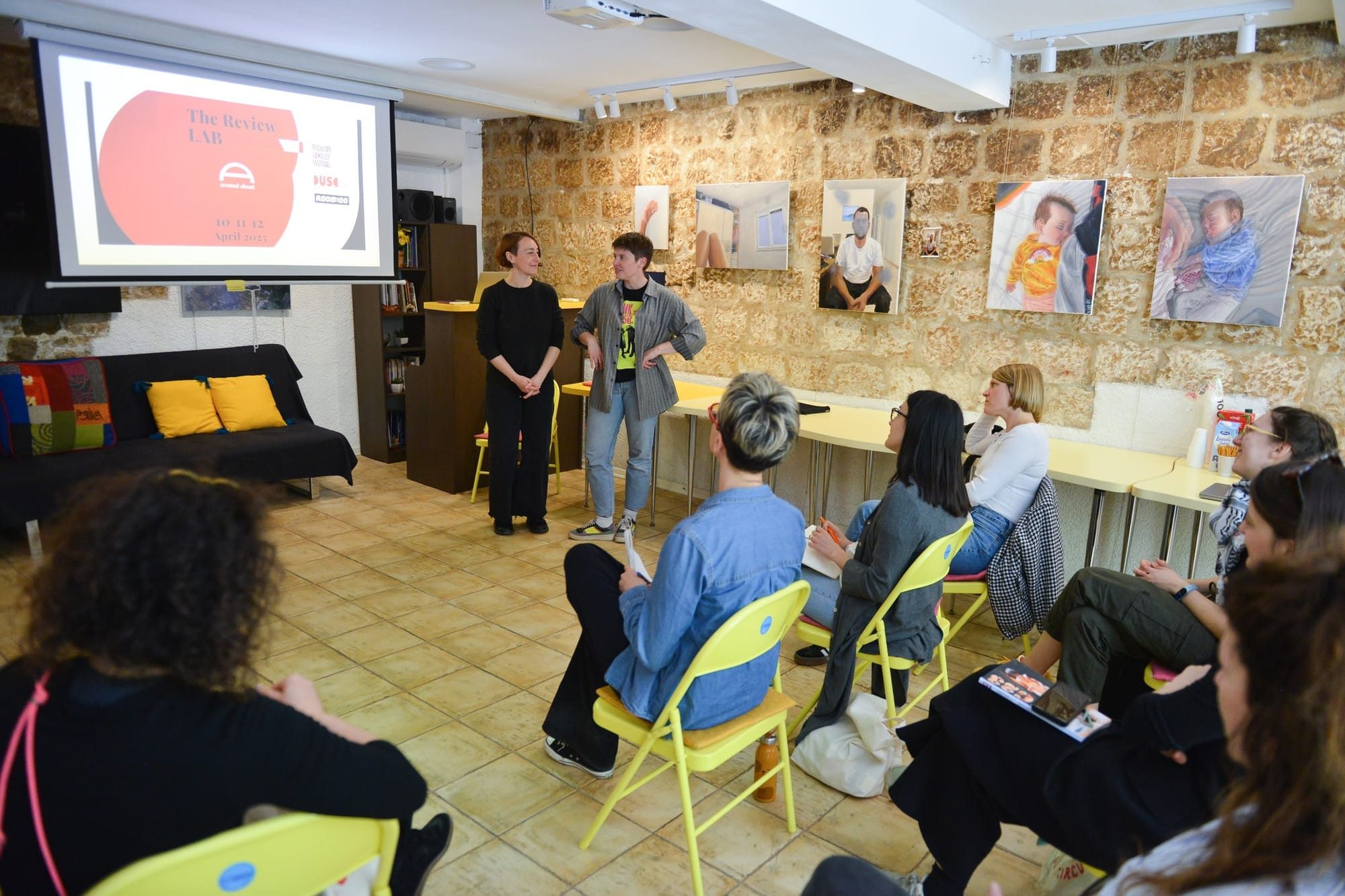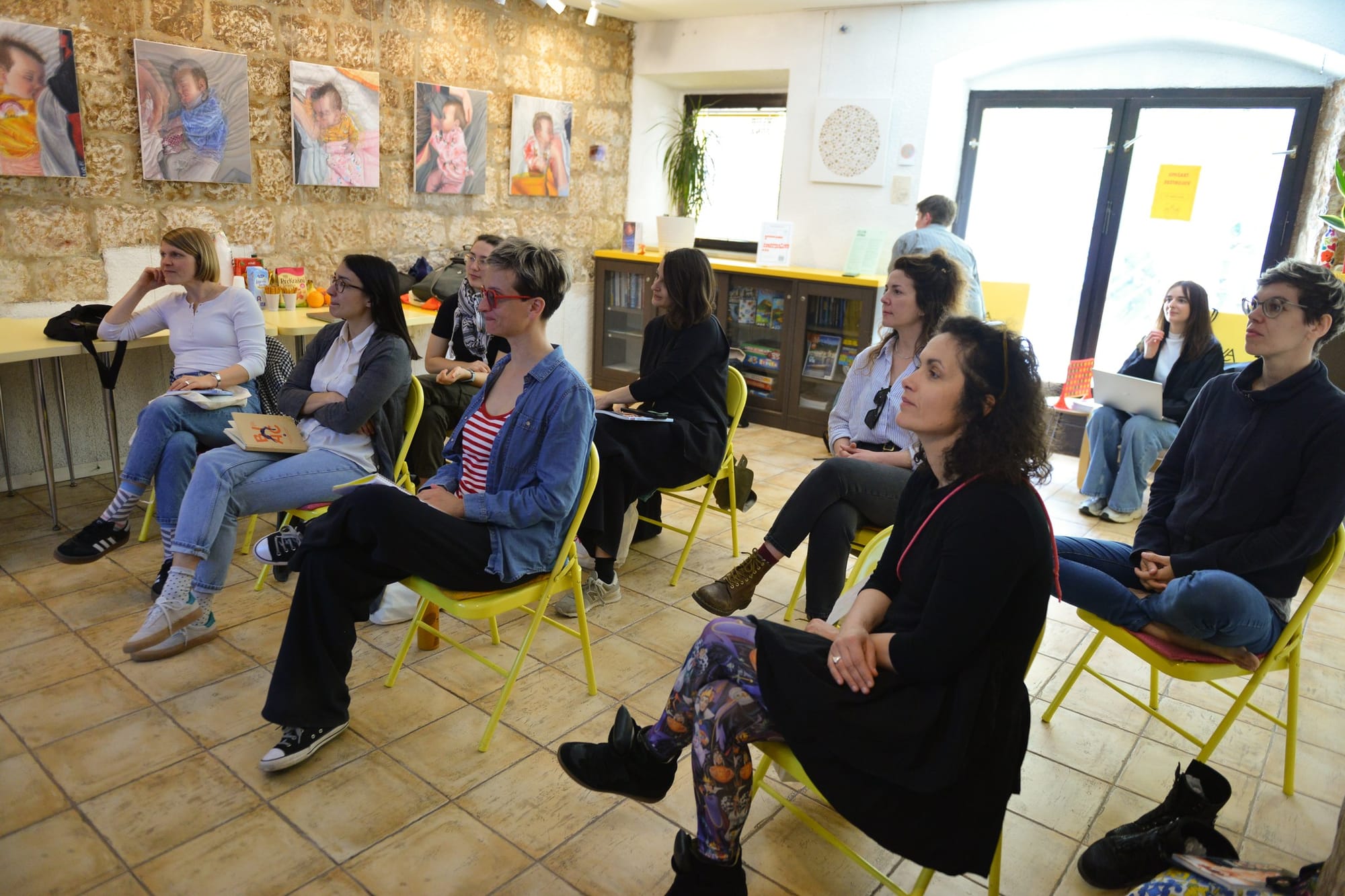Outdoor stages and audiences' behaviours: from reality to fiction in the city of Split
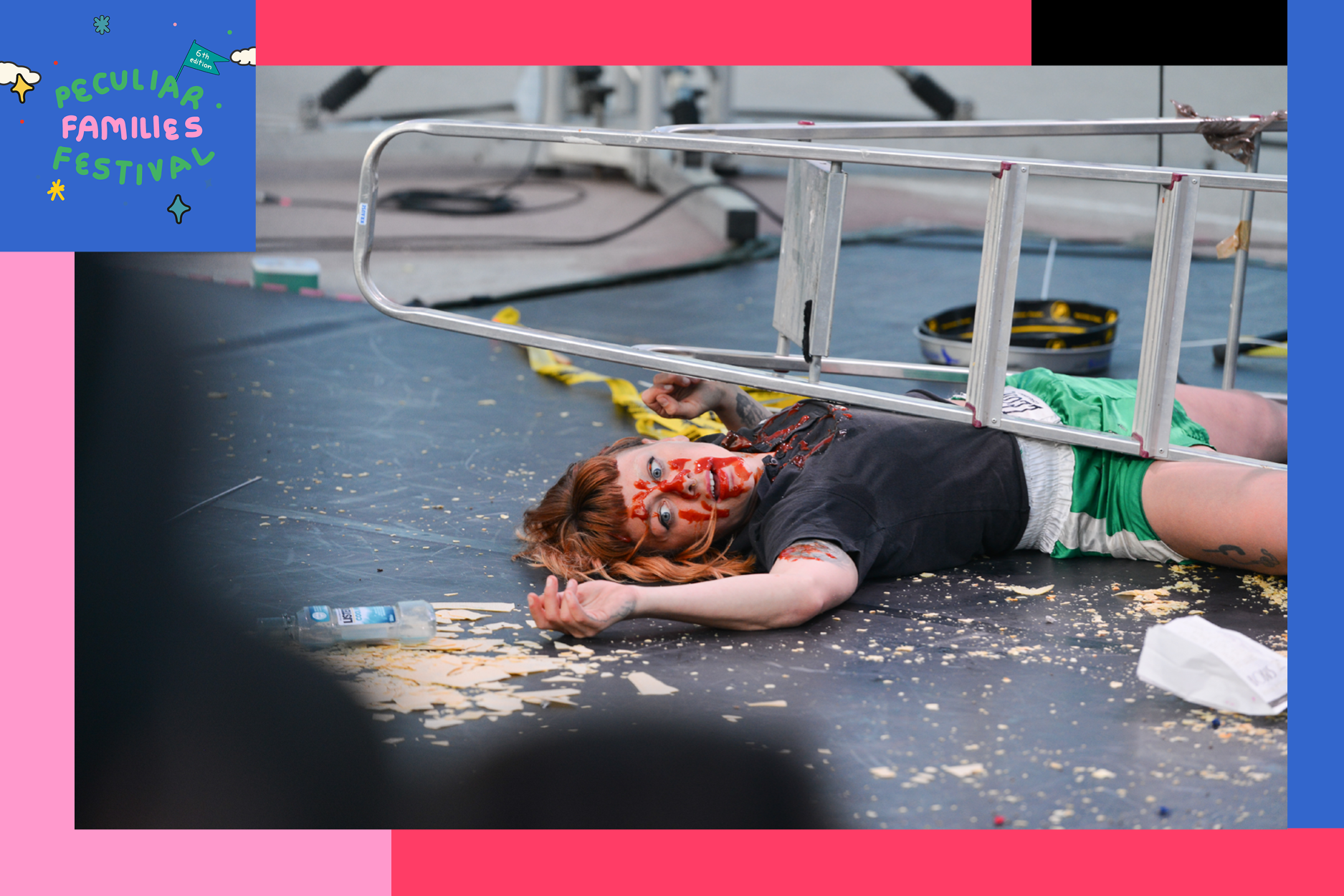
I had spent the previous day at several airports while travelling to Peculiar Families Festival, which also, for me, means "going home". To pretend to be a neutral spectator at the festival would be a lie. I grew up here and was in my final year of high school when the first edition of the festival took place. In 2020, I was on the floor of Split's Youth Centre, writing out the festival programme in calligraphy, and I have attended five of the festival's six editions.
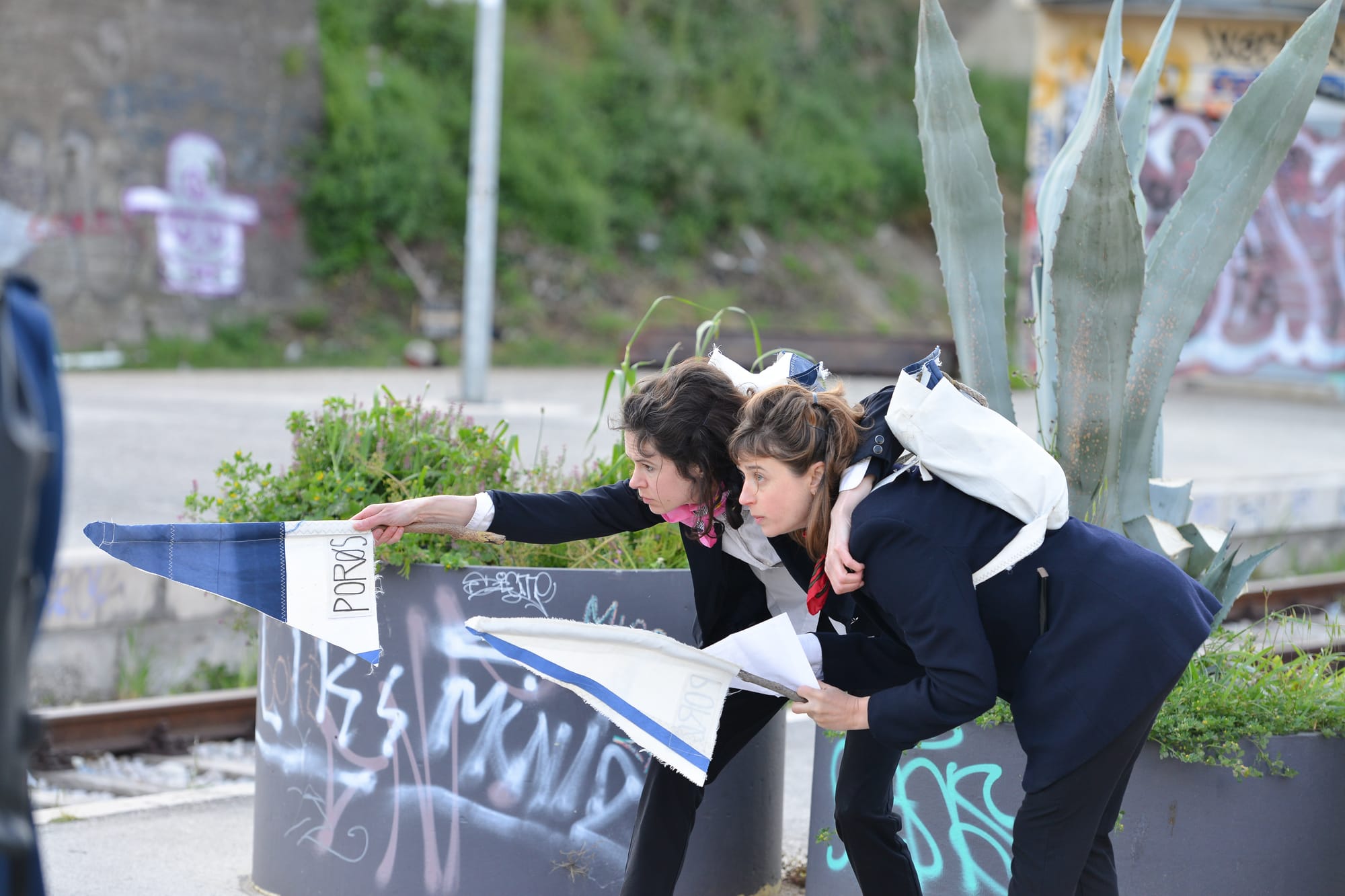
This year, the entire program was placed in public spaces, primarily in the city's peripheral neighbourhoods. This is partly a consequence of the absence of suitable theatre infrastructure in town—an absence produced largely by the unwillingness of traditional institutions to take risks in programming contemporary circus. Performances by artists from Belgium, Finland, France, Norway, and Germany were staged, alongside artists from the European Hand to Hand project. With a collective questioning of the notion of social ecology through contemporary circus, Hand to Hand edged towards its appropriate ending through its presence in Split, the city with a beautiful coast, entrapped in mass tourism and surrounded by two of the country’s eight "black spots" according to Croatia's ombudswoman (black spots mark locations burdened by decades-long inappropriate management of industrial waste).
The early morning air was crisp as I looked out to the panoramic view of the Split port and parts of the old town, bothered only by the statue of the former Croatian president in the middle of it. Even though the clock had not yet struck seven, the day was already quite bright (typical for April), but life in the city had not truly awakened yet.
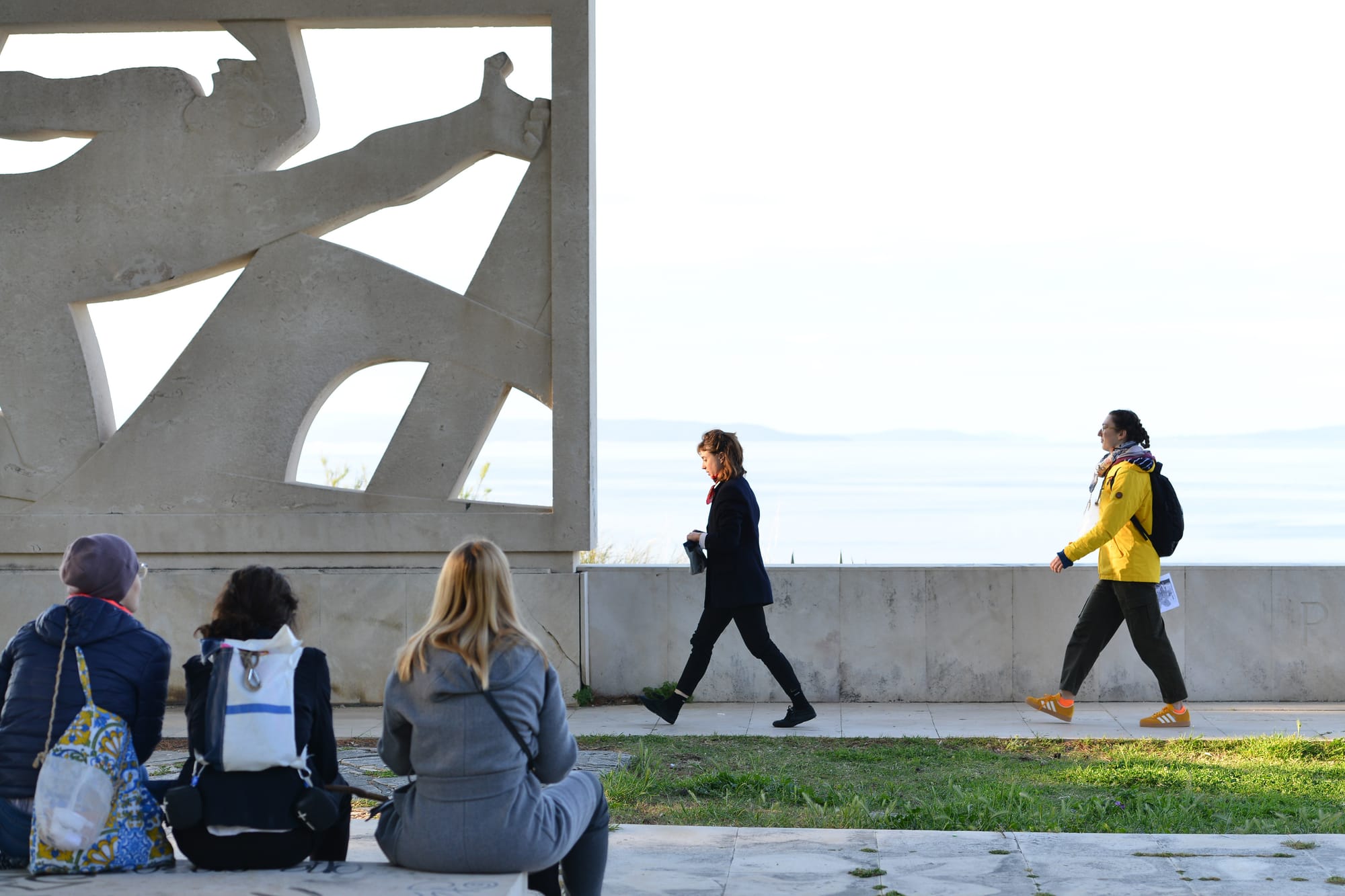
The reason for my early start was attending the Hand to hand performance PORØS. Together with other motivated spectators, mostly friends and acquaintances, I joined the performative walk through the less visible streets of the city centre, which had been held hostage to mass tourism for the better part of the year. It didn't take long for Mathilde Roy and Darya Efrat to take us out of morning grogginess and into their imagination of Split by focusing on the often overlooked details. PORØS, an in-situ performance inspired by the working environment of a maritime workshop renovating wooden boats, and a professional fisherman in Denmark, was adapted to the landscape of Split.
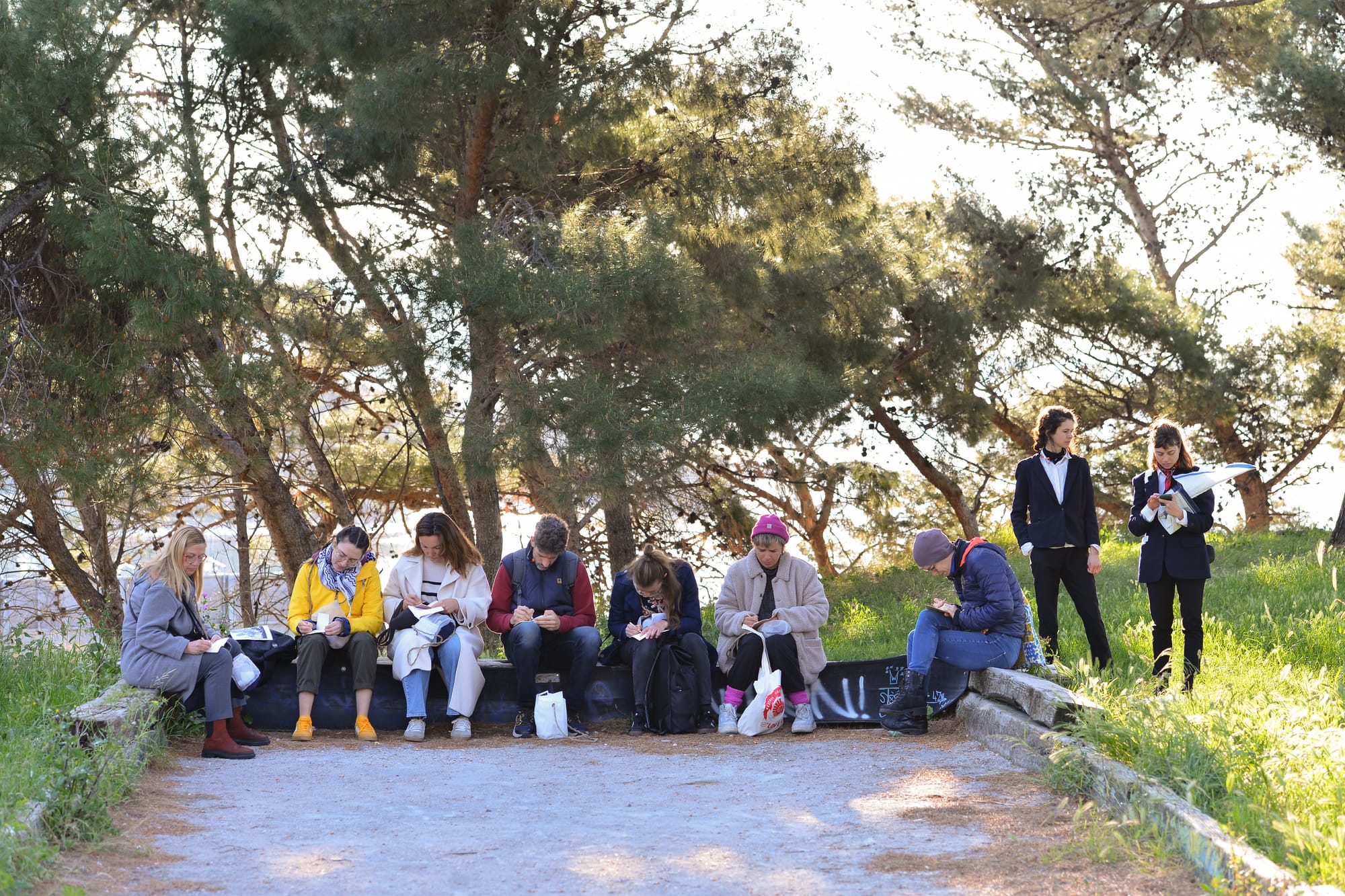
Warmth would be the best word to describe this walk, in which an intimate group setting reinforced my nostalgic reflections related to Split from before mass tourism took over, the glimpses of which I could still feel, even if it had to be at seven in the morning on a work day in April. The artists' excellent observation skills allowed them to tell people's stories through transportation. As we welcomed the night train from Zagreb to Split when it reached its final stop, and shared our farewell to a ferry on its way to the next adventure, we were able to witness Split belonging to students and workers. Although the occasional contextual differences led to the overlooking of some elements of the city, such as a playful moment occurring next to the wall with a hate symbol, the artists were able to capture the essence of the details, pointing to the importance of simply stopping and observing, even if just for a moment.
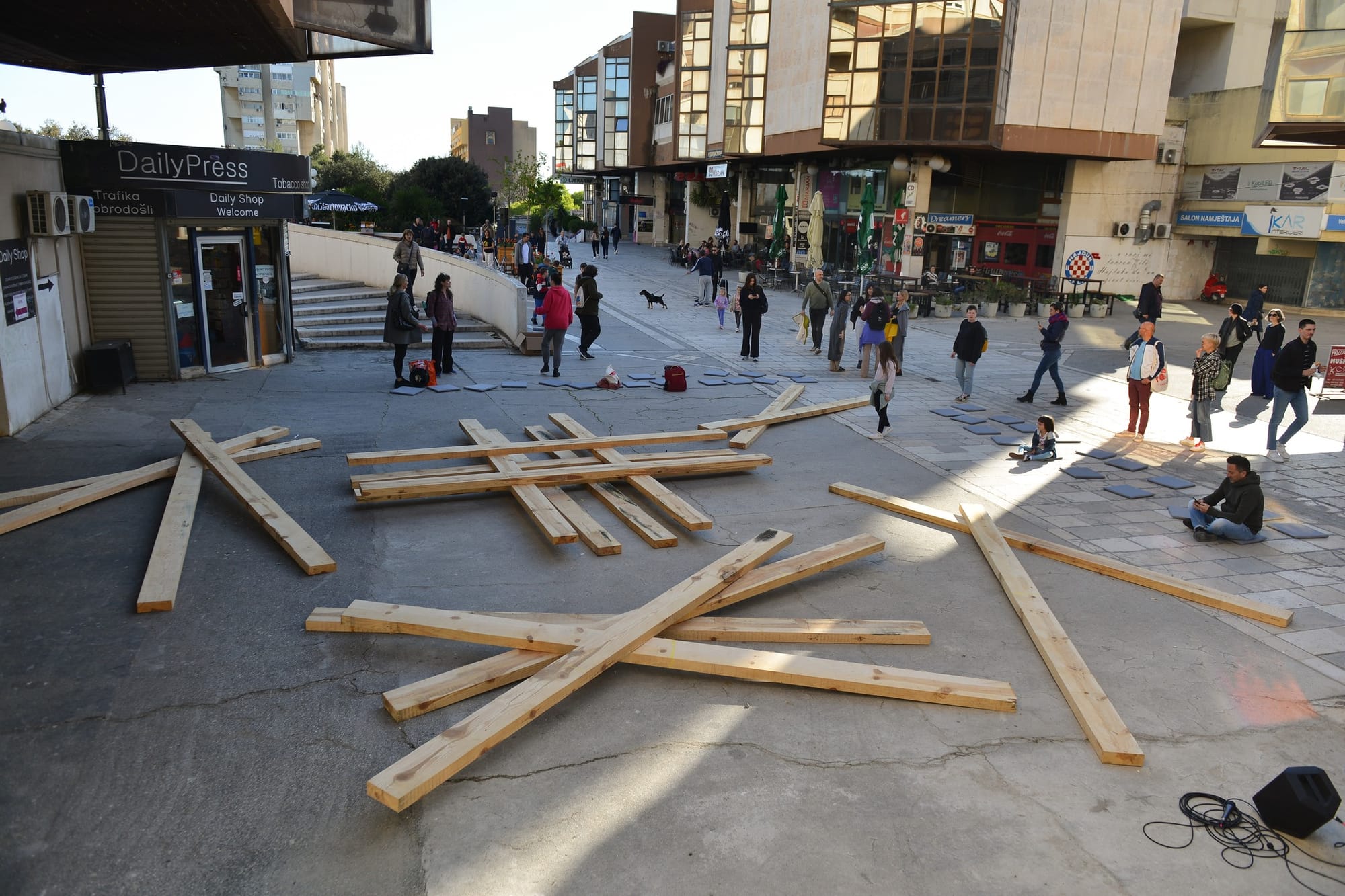
The next day, we moved to the Split 3 neighbourhood, another location chosen by the PFF 2025 artistic direction. Built in the 1970s, this brutalist landscape was seen as more than just a housing solution, with a design reflecting an experimental attempt towards social living. It seemed that fifty years later, a new kind of experiment was taking place: an attempt to consolidate very different perspectives on circus arts, the divergent relationships between the artist and the audience, and answers to who gets to "own" the public space.
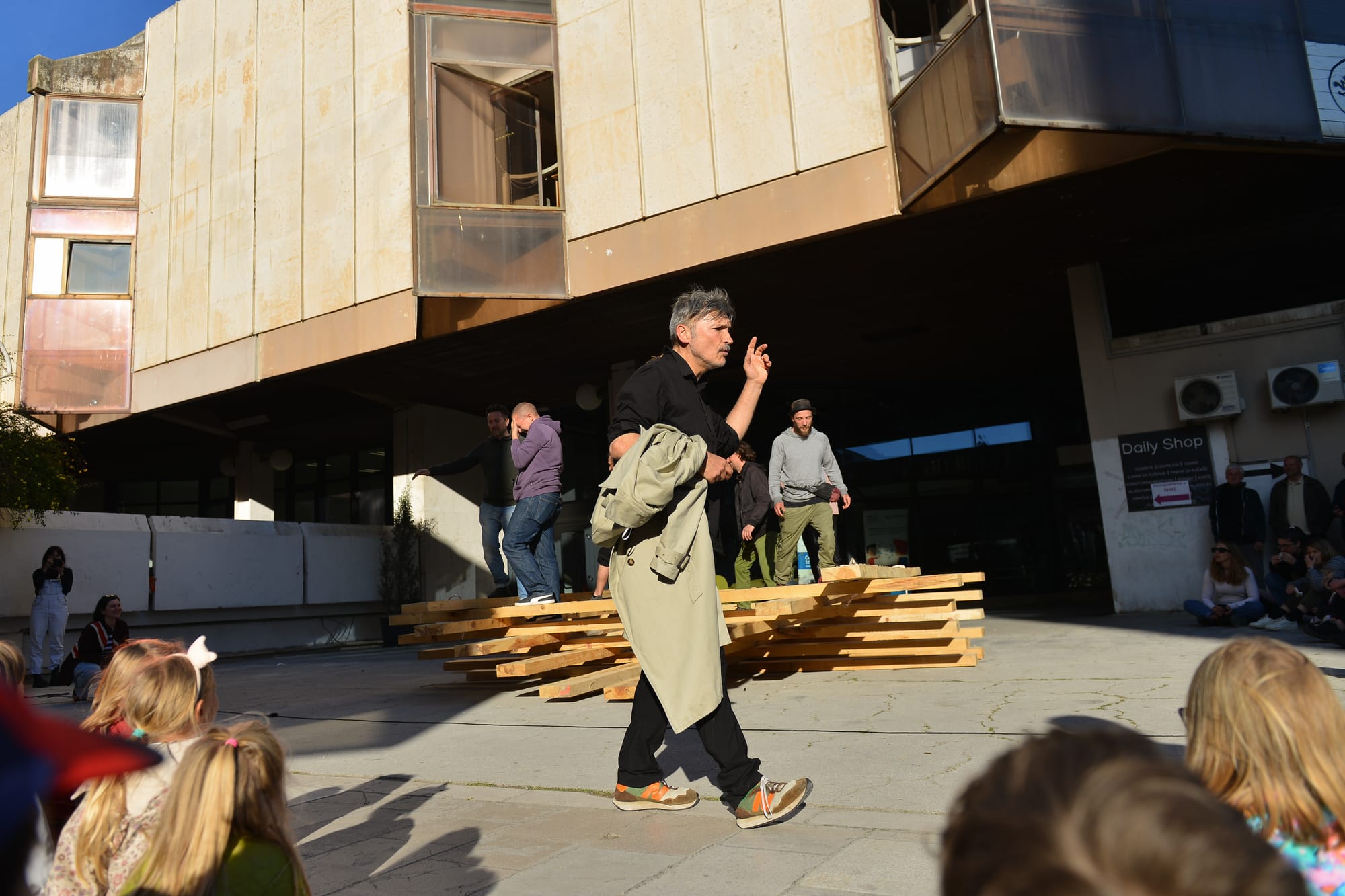
In the afternoon, Cirque Inextremiste's Damocles takes the stage, marked only by the presence of wooden beams and grey cushions resisting the urge not to fly away with the sudden gushes of wind as they await audience members. Behind them, pedestrians continued their movement, with occasional glances at the unexpected setup. Damocles, the servant of Dionysius I of Syracuse, is best known through the legend of “the Sword of Damocles”. According to the story, Damocles, always praising the fortunes of his master, gets to experience his extravagant lifestyle, only to realise that throughout the grandiose dinner, a sword was hanging right above the throne, dangling over his head while being held only by a single hair of a horse's tail. I don't care much for legends that justify the riches of the leaders with the supposed danger that accompanies them. However, the expression in this show of the sword of Damocles, marking a situation of impending threat or disaster, fits perfectly.
I arrive with high expectations for this participative experience. Not only is Cirque Inextremiste one of the references that appear regularly in my conversations with circus professionals, but I was also drawn into the humorous and cooperative universe of their show Extrêmités, which I got to see last September in Barcelona. However, only a few minutes into the show, I already felt the need to roll my eyes. It may be the three gender studies courses I am taking this semester speaking through me, but I could not help but be annoyed at the fact that the performer, who takes on the role of a guide for this peculiar encounter, invited a woman from the audience to perform the role of emotional support, providing care and encouragement, while a man was invited to hold the heavy wooden beam.

Although the latter changed as more beams were moved, this stereotypical division of labour at the beginning made me more hesitant to receive the lessons on togetherness and trust spurred throughout the performance, which oftentimes felt one-dimensional. Yet, despite being acutely aware of this, I found myself on stage, reading poetry prepared by a man to another man holding a beam, attempting to make myself meaningful in this interaction where I seem to be a mere vessel. I cannot pretend to be an accidental audience member here. I am aware of the logistical complications behind the moment; the wooden beams were much heavier than expected, and at one point, the possibility of cancelling the show was discussed. Our guide's priority was the safety of everyone involved, but it is still interesting to note how quickly we can fall back to typecasting one another when the physical risk is increased, becoming less aware of the risks of reaffirming existing social roles.
As the show progressed, more and more spectators transformed into participants and their cooperation was powerful, not only as it challenged the normative division of stage and audience, but also as it blurred the lines between what seemed to be two types of audiences: individuals deeply entrenched in the festival and the accidental passer-bys, mostly neighborhood residents who allowed their curiosity to overcome the urge to continue with their activities after a glance. Yet, the feeling of mismatch resumed and I found myself feeling the impulse to attempt to translate between these two worlds I am familiar with, that of the Split neighborhood which was an integral part of my daily rhythm for years and of the French contemporary circus, whose vocabulary I got accustomed to throughout the years of living in France. However, I knew that any attempt at interpretation would be equally as clumsy as the current encounter, because the divide is not a reflection of a few cultural quirks, but of an important distance between social imaginaries offered by the performance and those available to the people present on the square.
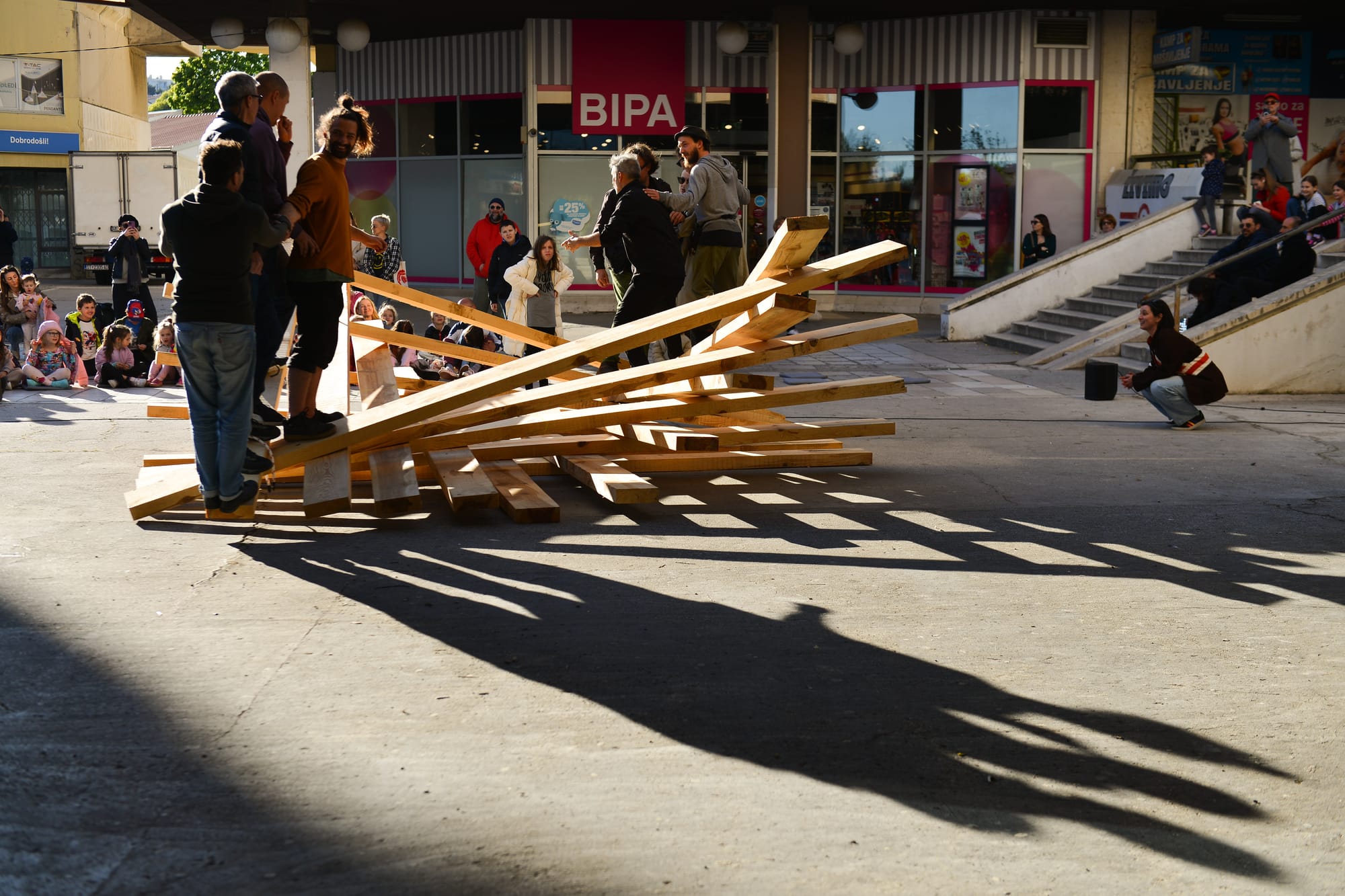
Instead of being transported into a different universe, I became more strongly encircled by the present one. Still, the questions of risk and balance hanging by a thread reverberated loudly among the skyscrapers of Split 3. In this context, the sword of Damocles was not simply the risk created by the instability and weight of the beams for those who walked on, held or carried them. The highest impending threat was hanging above the artist's head as he navigated the interactions with an environment that has seldom seen contemporary circus, let alone a participative performance that questions the typical boundaries of this artistic field. The company's website describes the work as one questioning "the trust we give each other when faced with a difficulty." This questioning was deeply present in every stage of the performance. It has been shown that trust is delicate; it can be created, questioned, retracted and conditioned. Trust is not always a simple yes or no, and it does not have to follow a chronological timeline. I believe the encounter made this valuable lesson available for everyone involved. The construction that remained after the performance was quickly occupied by children. Once the performer moved beyond the attempts to establish a common language (through a language that was foreign to all), the trust resurfaced, and playful laughter took over.
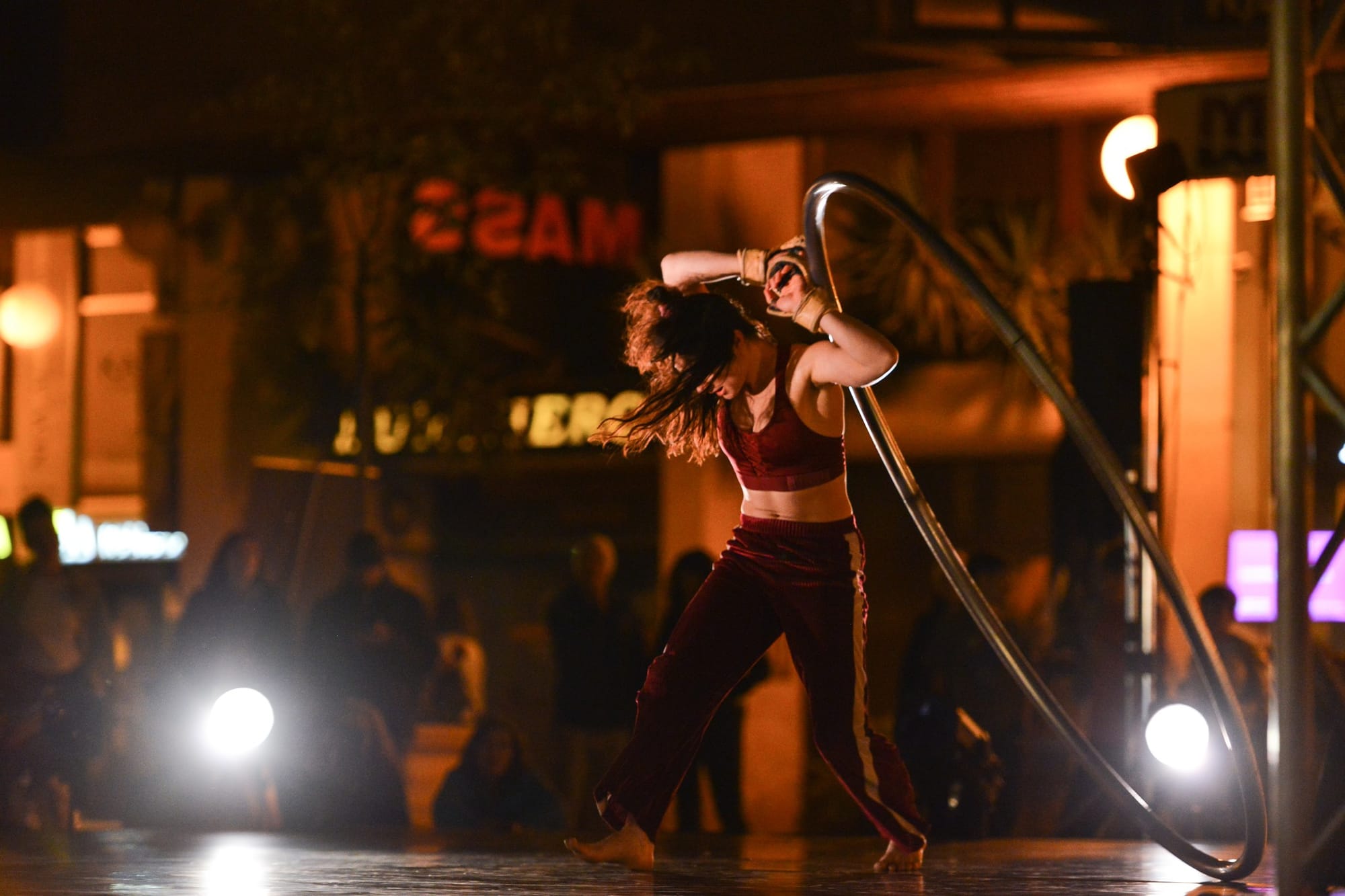
As the day moved into night, new performances awaited us, on a different part of the same square, with a "real" stage and layers of seating, the first provided by the organisers, and the second created organically by tables of nearby bars on both sides of the stage. This time, we were met with Lontano and Instante from Cie 7Bis, with a simple concept behind them: one human, one cyr wheel and the interaction between them. Yet, within these clear shared guidelines, we were able to witness completely divergent approaches to the relationship between the human and the object. Marica Marinoni's Lontano defied the typical occupancy of the inner space of the cyr wheel. With a clear allusion to a fight, through the quality of movement, fighting gloves and the sound effects which almost seemed pleonastic due to the clarity of the former two elements, Marinoni offered an interaction in which the cyr wheel simultaneously lifted her up and dragged her down.
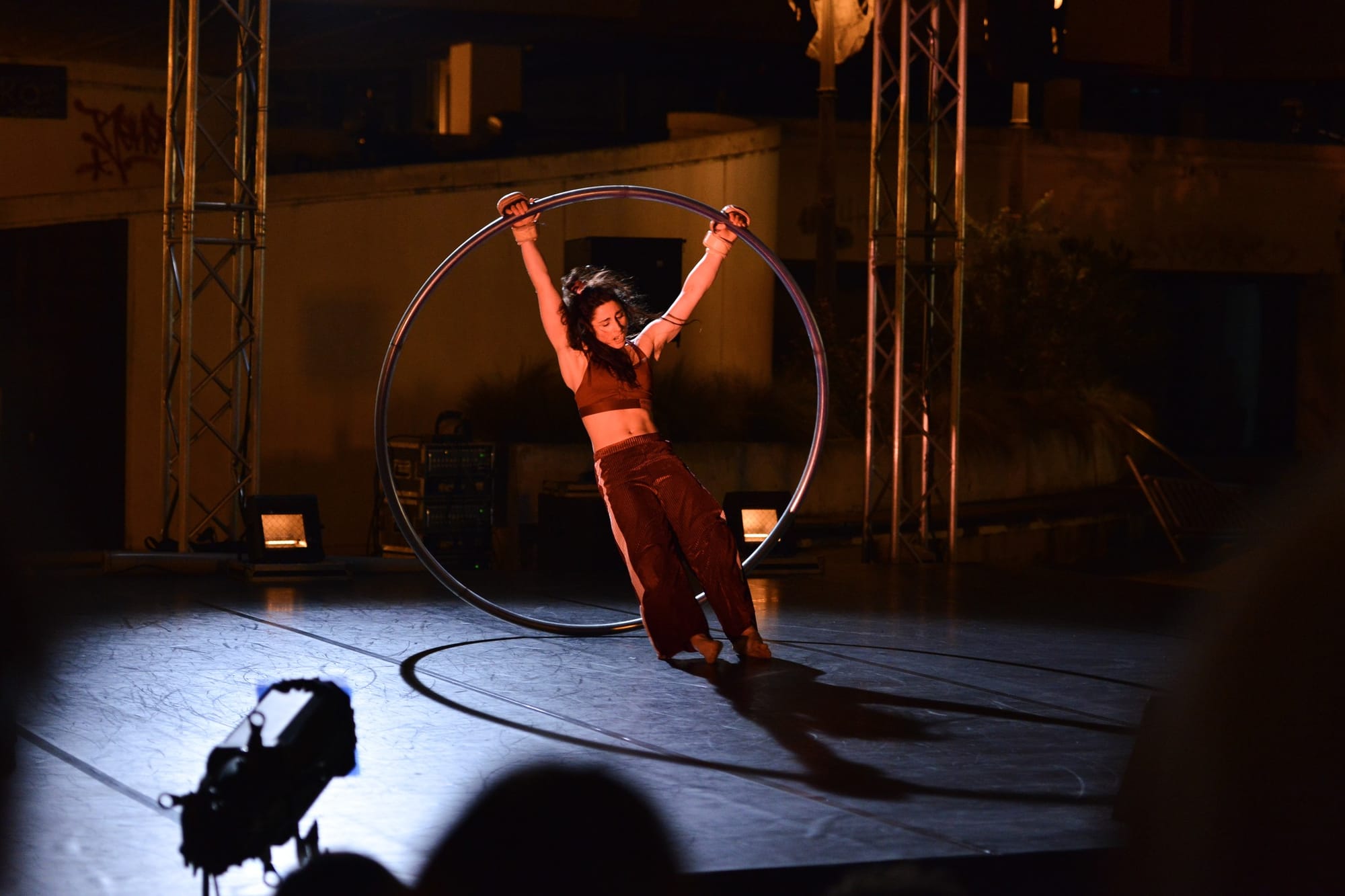
The distance present in the title found its home in the verticality of Marinoni's movement. Halfway through the performance, the artist stopped, turned the attention from the cyr wheel to the audience, and shared that it seemed like the cyr wheel had won tonight. An injury occurred, making her unable to continue with the performance. We did not get to see the planned ending of this crafted reflection on her relationship with the cyr wheel, as the real and present one took over. The moment served as a reminder of the real risk carried by engaging in circus disciplines, which made the fight we had witnessed even more impactful. The artist recalled for us that with the pushing of boundaries that contemporary circus entails, it is equally important to have an understanding of when boundaries need to be reestablished.
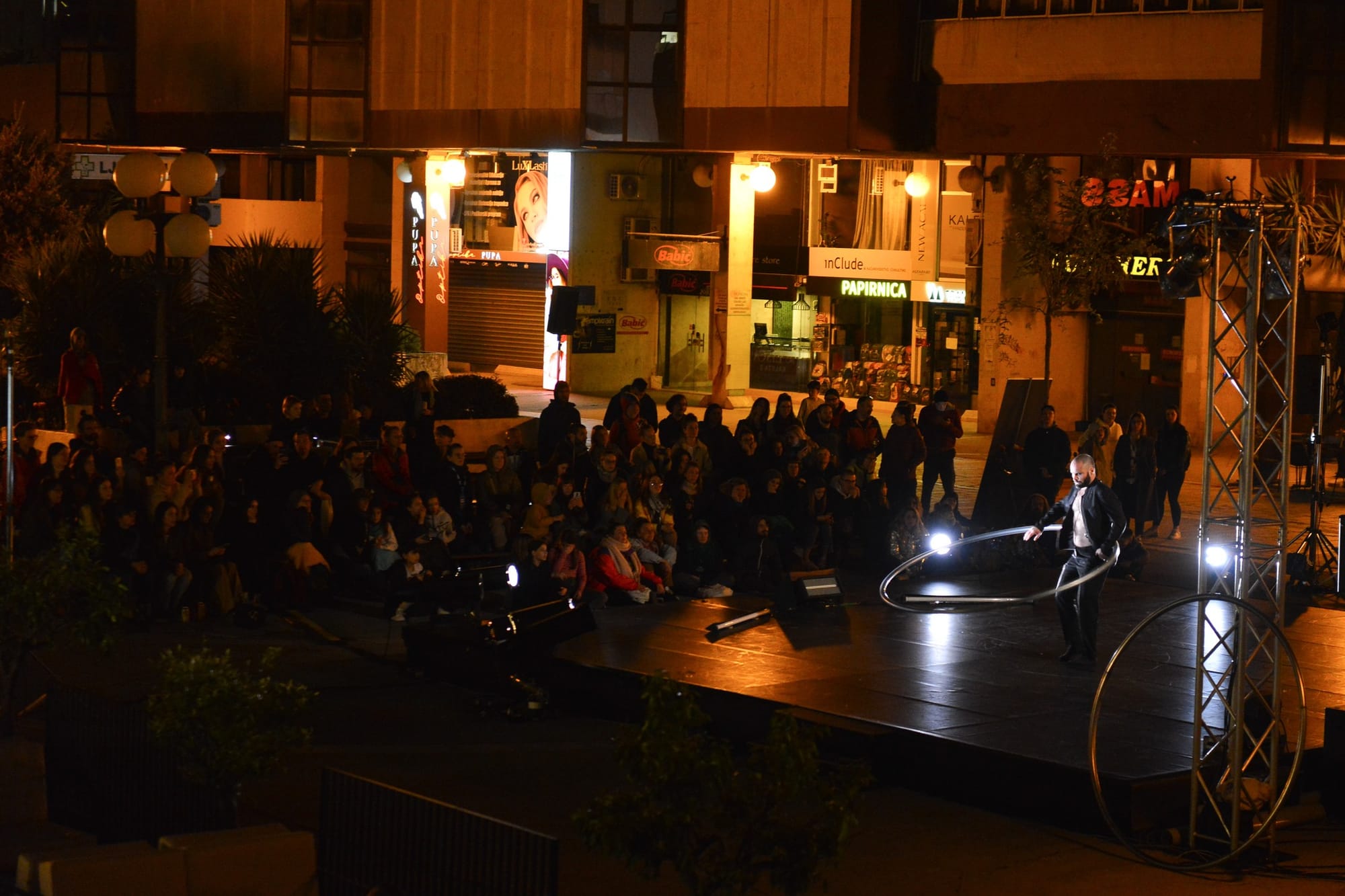
Accompanied by loud applause, Marinoni exited the stage and was followed by Juan Ignacio Tula and his performance Instante, which centred extreme physicality with minimum bodily movement. The repetitive circular movements of the cyr wheel, alongside the static appearance of the body, made it seem as if the artist is spinning a hula hoop, certainly not a heavy aluminium ring larger than himself. In this hypnotic process, I would occasionally recall the real weight of the apparatus, becoming aware of the exhaustion created in the artist's body. Going back to the basic principles of his discipline, the weight and the spin, Tula asks familiar questions to his apparatus, but, compared to the majority of cyr wheel artists, he provided a starkly different answer, completely inverting the typical approach.
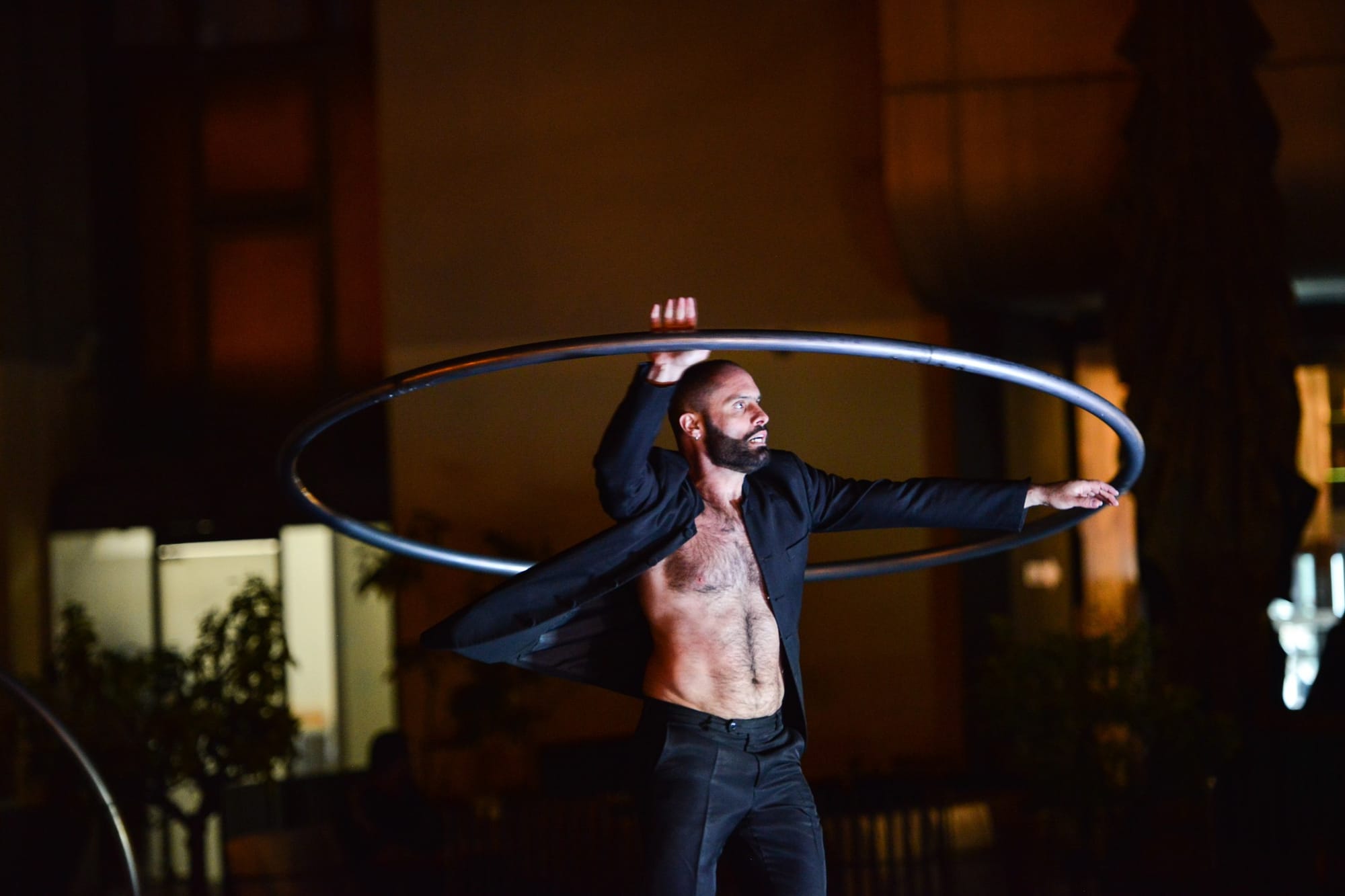
Accompanied by strobing lights, Tula messed with the perception of time itself. The relationship between the two is dynamicized with the artist's manipulation of his shirt and some aluminium foil, which became the vessels of change, the messengers of the impermanence of time. There was an impression of an entire life flashing before our eyes. The final moments of silence were disrupted by loud music coming from the bars nearby. Even the manipulation of time was subjected to the currents of daily life. It seems that the two lives, the daily and the extraordinary, were only able to speak over each other, with the audience, both there for the performance and the ones in the bar, became spectators to this carnival of misunderstanding.
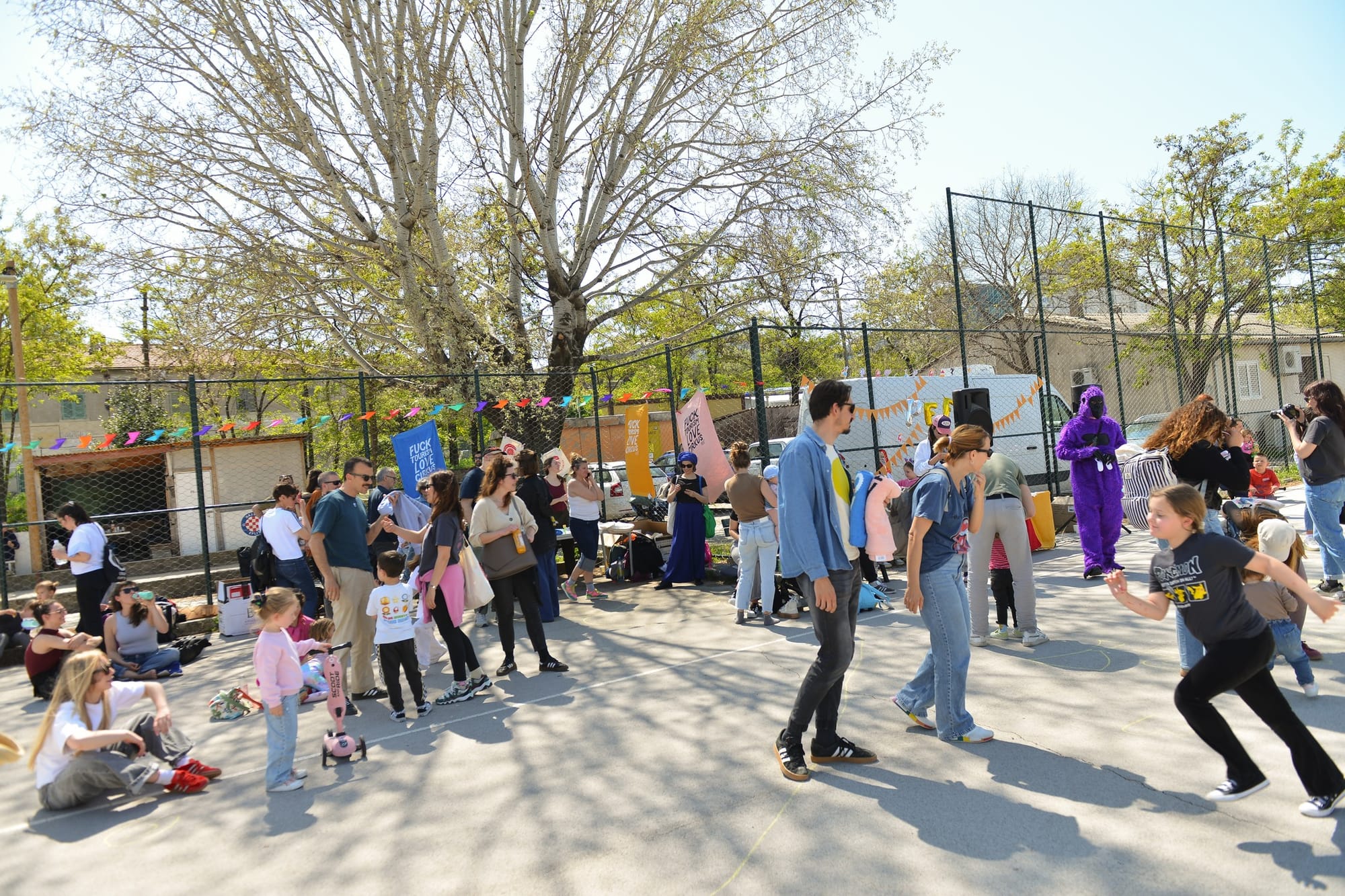
The last day of the festival welcomed us to the playground of Split's Kopilica neighbourhood. Unlike Split 3, you will not find Kopilica featured in an exhibition of New York City's Museum of Modern Art (MoMA), and it is certainly not associated with the word utopia. Yet, it is precisely a glimpse of utopia that I experienced that day. Kopilica, home not only to its residents, but also to the city buses' parking lot and the national railway stop (as well as a failed one-stop metro project), lacks basic infrastructure that makes a neighborhood liveable: squares, parks, schools, and cafes (we are, in fact, in the Balkans and the coffee culture is taken seriously). It's a meeting of peripheries: a neglected neighbourhood that seems to be cared for only by its residents.
In this context, it hosts on its playground a neglected art form, contemporary circus in Croatia. The paradoxical meaning is the elephant in the room: left spaceless and statusless, able to keep its head just above the water only through the perpetual efforts of a handful of people, including the team behind the festival, the peripheral and peculiar condition of a district in Split and an international art form often independent from societarian rules can meet. The day started shaky, as the climate crisis made its big entry with scorching heat that resembled Split's weather in August, not in April.
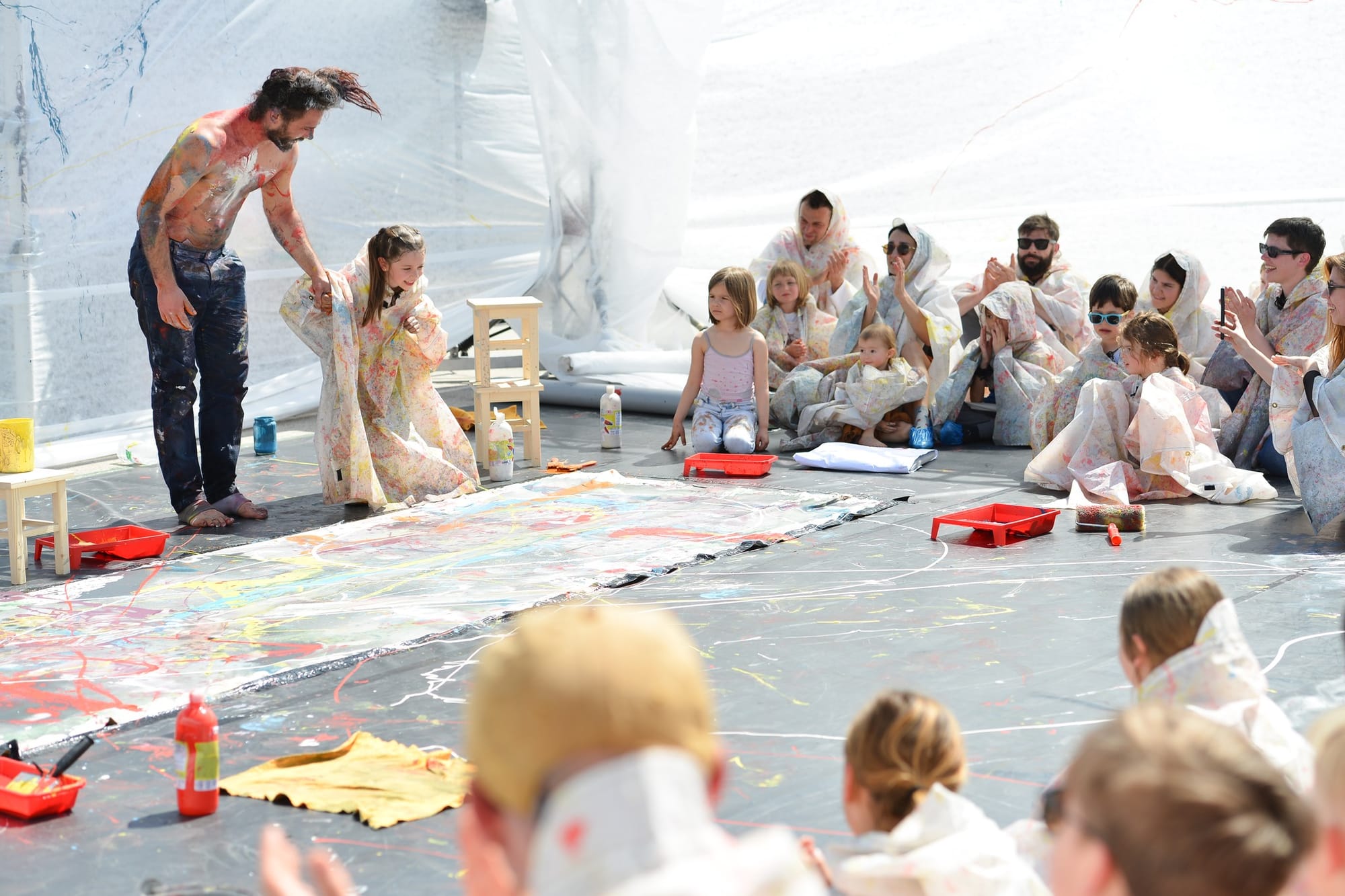
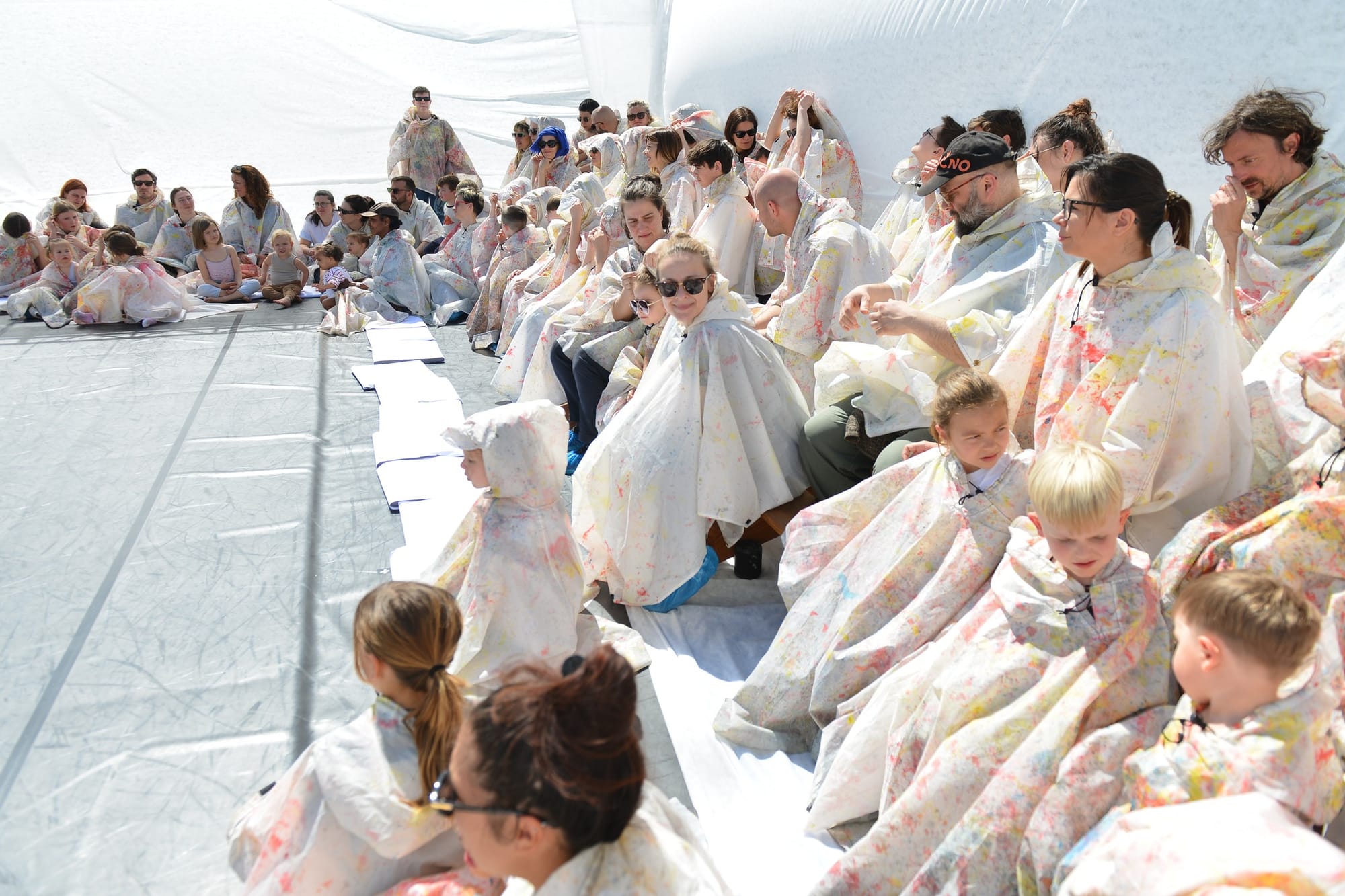
The plastic ponchos, given to the audience by a member of the company Grensgeval, for protection against the paint that was flying everywhere during the performance Plock!, certainly did not help with the already heated atmosphere. All of the audience eventually moved to the shaded part of the performance space as the artist was pushed by the difficult conditions, trying to simultaneously capture the people's attention while having to step into water regularly just to be able to walk on the stage, torched by the midday sun.
The increasingly unpredictable and extreme weather events could significantly impact the capacity of contemporary circus to occupy outside public spaces. However, as the reshaping of conditions in which contemporary circus happens is shifting, not only through the climate crisis, but also through the rise of far-right policies and drastic budget cuts to culture, Balkan circus communities seem to operate in a shaken environment as if it were stable ground. It's another clash of experiences whose presence I feel, that between the international artists, who appear to be pushed to the limits by the experience of this festival, and the "local circus people", for whom each bizarre challenge (such as being asked "are you gay" by several police officers who keep calling because the name of the event contains the phrase ‘peculiar families’) carries certain familiarity and is approached with ironic humour. This playful approach is the fuel that keeps us going through all the barriers, the weird, the unnecessary and those that keep reappearing after we thought we had moved past them. Most importantly, the burden is shared, even while everyone in the organising team is juggling multiple roles.
The panel guest is also the Children's rave party DJ and a driver (she might spend her free time emotionally supporting male beam managers); the social media manager hosts, drives during the pauses (because there is always someone to be picked up at the airport), and solves other logistical problems in the meantime; the artistic director performs such a delicate act of juggling so many "hats" that it is truly impressive how all of them are still in their place, instead of rolling off accidentally across the floor. All of them approach each of their roles with the same sense of responsibility and dedication.
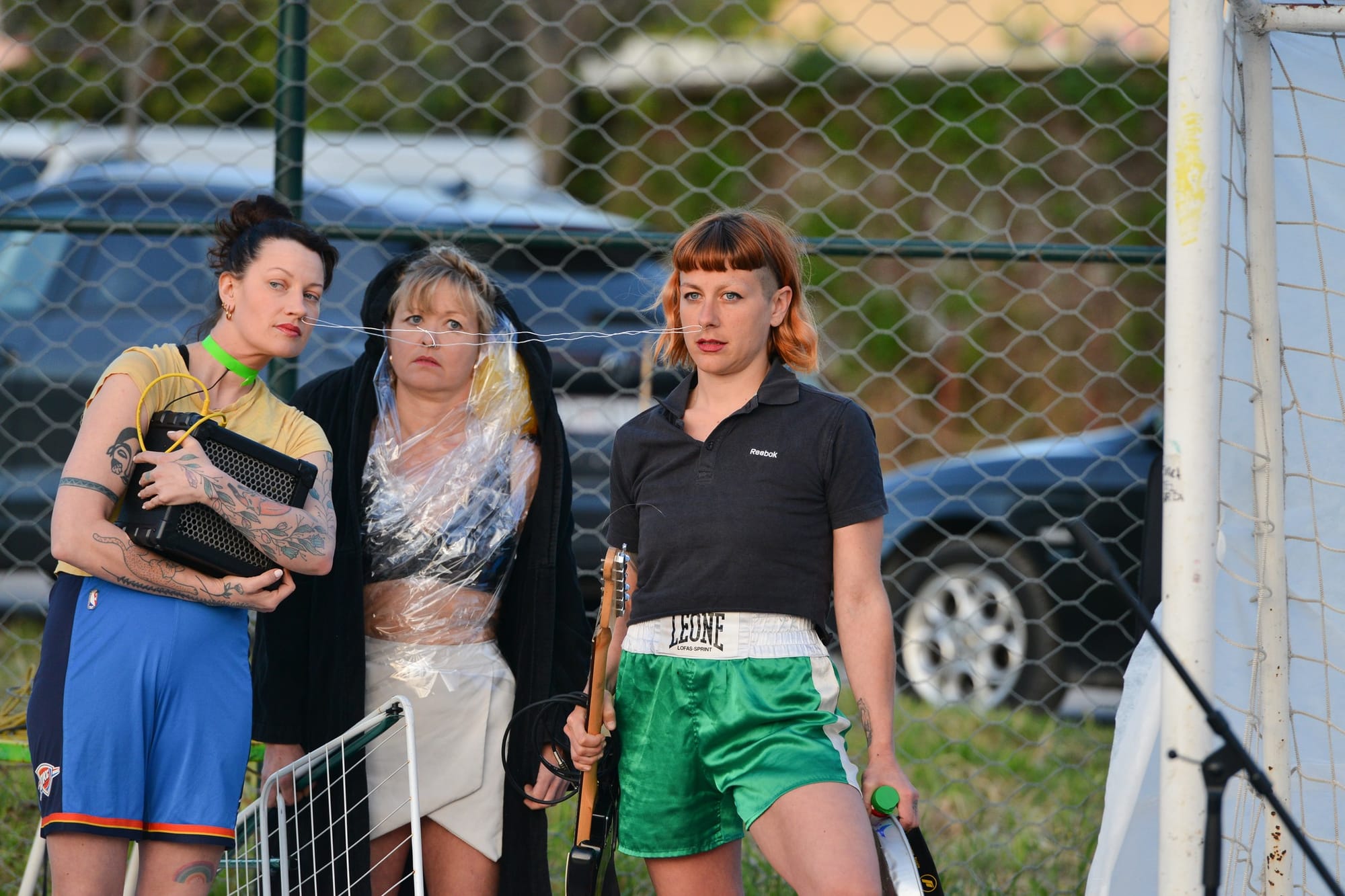
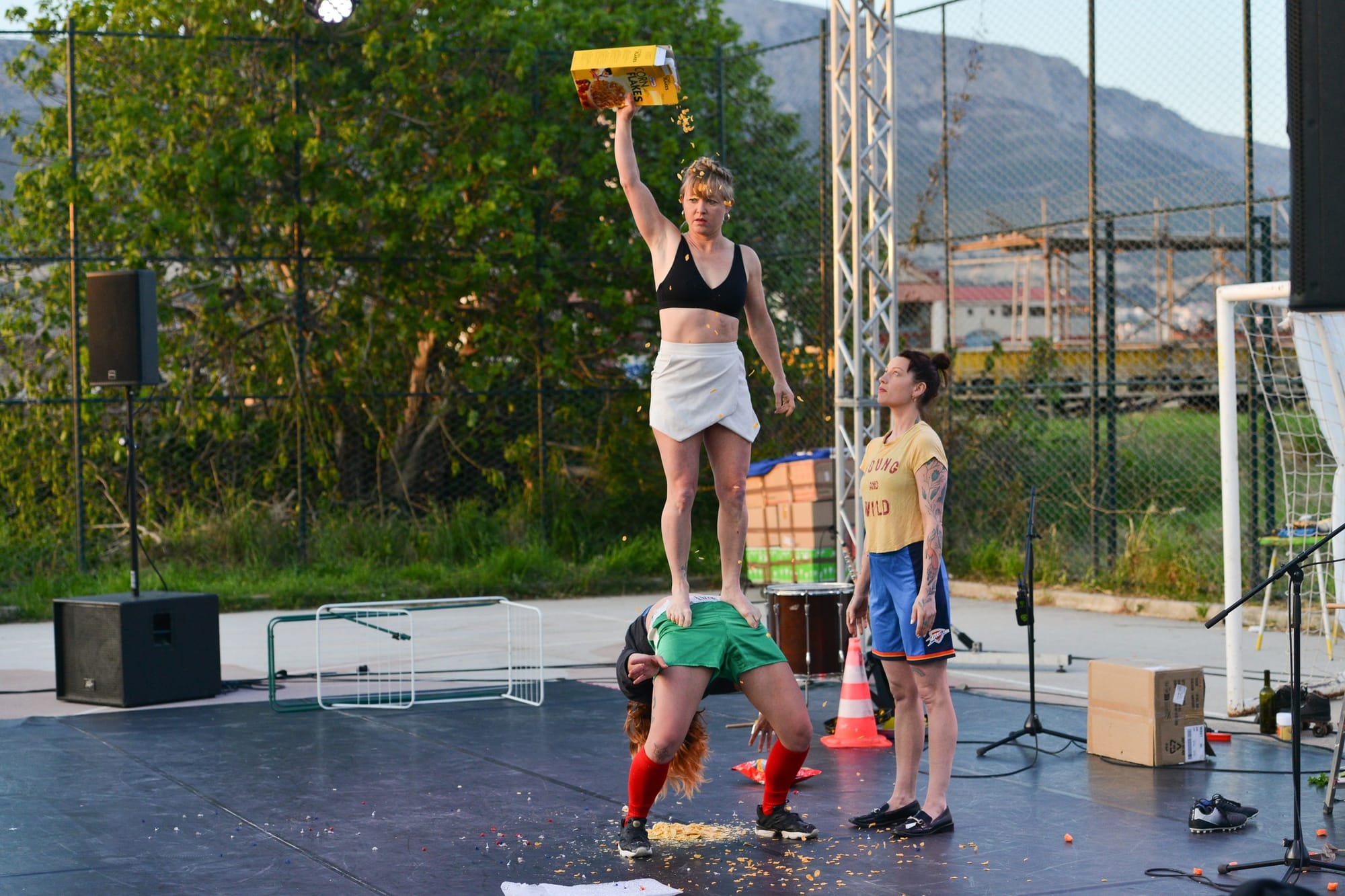
All of this effort is paid off in the closing evening of the Peculiar Families Festival. This time, the meeting at the margins does not lead to a clash. Instead, the craziness of punk circus and the peripherality of the neighbourhood, which entails the exclusion of the neighbourhood's residents from any kind of cultural content in their home, come together to co-create a new social imagination. My!Laika enters the stage, followed by immediate giggles from both children and adults as they look at the three women connected by a piece of string passing through their nose piercings. The body of one of the artists is contorted to the rhythm of ASMR-like chewing of raw vegetables, as if this bizarre sound source is controlling the movement. The trio, as peculiar as the name of the festival, does not shy away from embracing the ridicule, in which the stunning contortion skills only provide the backdrop for the main star of the show: absurdity.
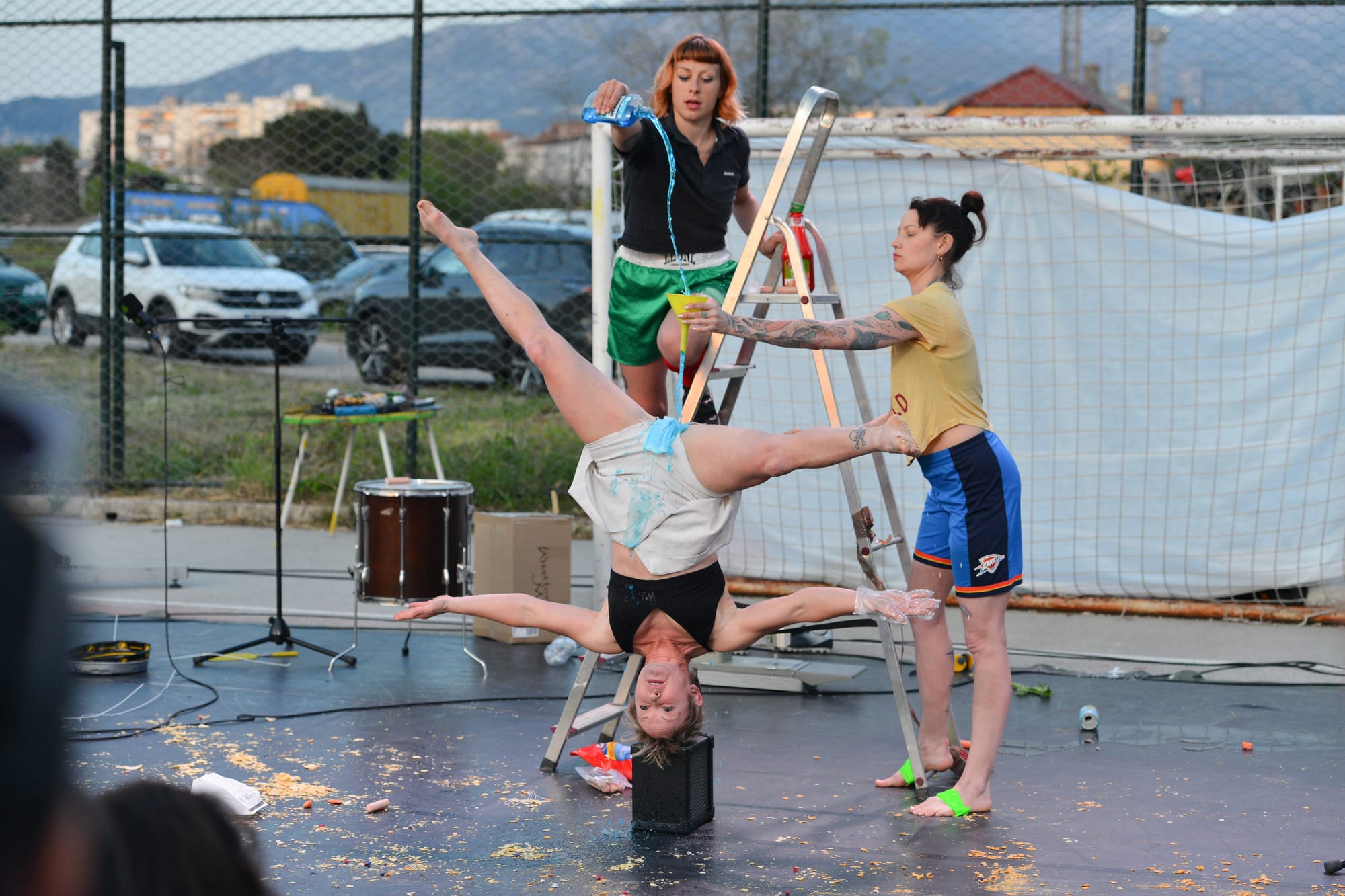
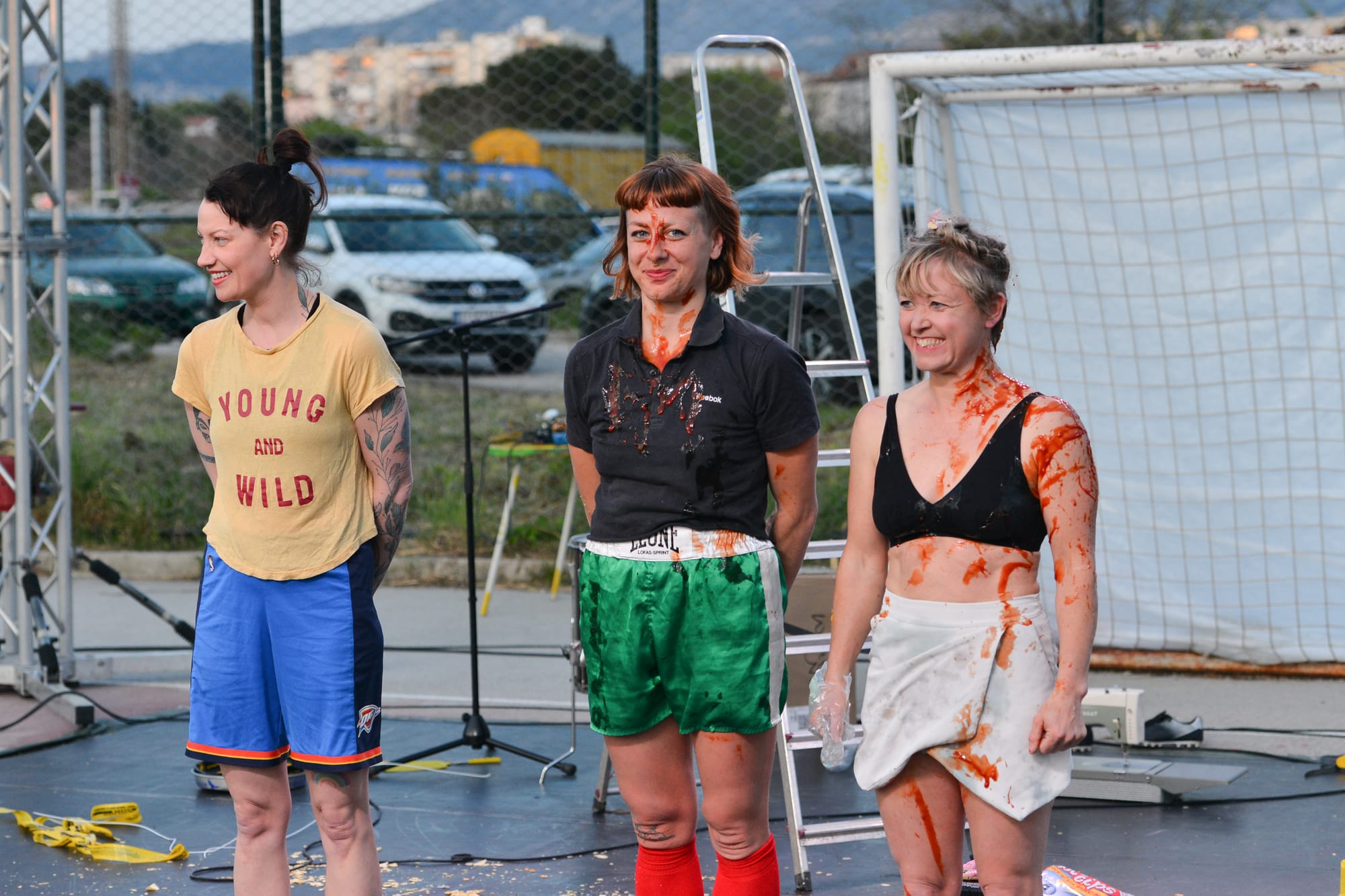
The shock is followed by disgust, and all of it is infused with laughter. A man walking his dog stops outside the playground and continues to watch with a face of confusion, accompanied by slightly uncomfortable laughter. I wonder if his gaze slides from the performers to the background of chuckling children seated in the unexpected theatre that erupted from the very ordinary playground, which he must pass every day. No Magic does not take absurdity for granted, they try to "one-up" it with each following scene, from the unlikely band in which the sausages steal the spotlight (no double-meaning intended, at least on my side), to the head-balancing on a speaker as Listerine is poured on the externally placed menstrual pad, a moment as irrational as real-life commercials with blue liquid and the absurd fact that period products were only tested with actual blood for the first time in 2023. The entire impression is perfectly blended into a classic ketchup-covered-death end scene placed in the scenography of scattered objects and crumbled food on the floor.
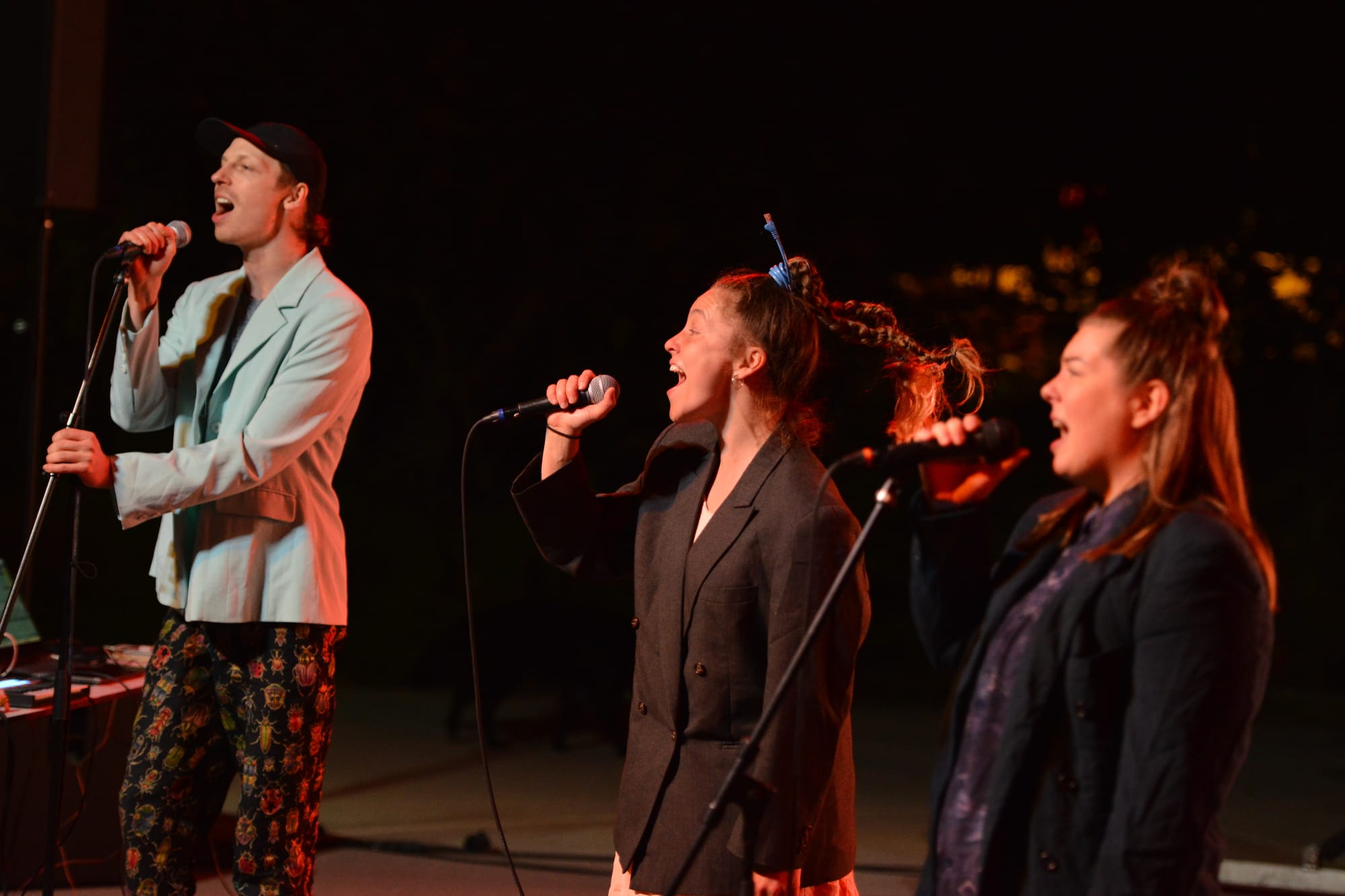
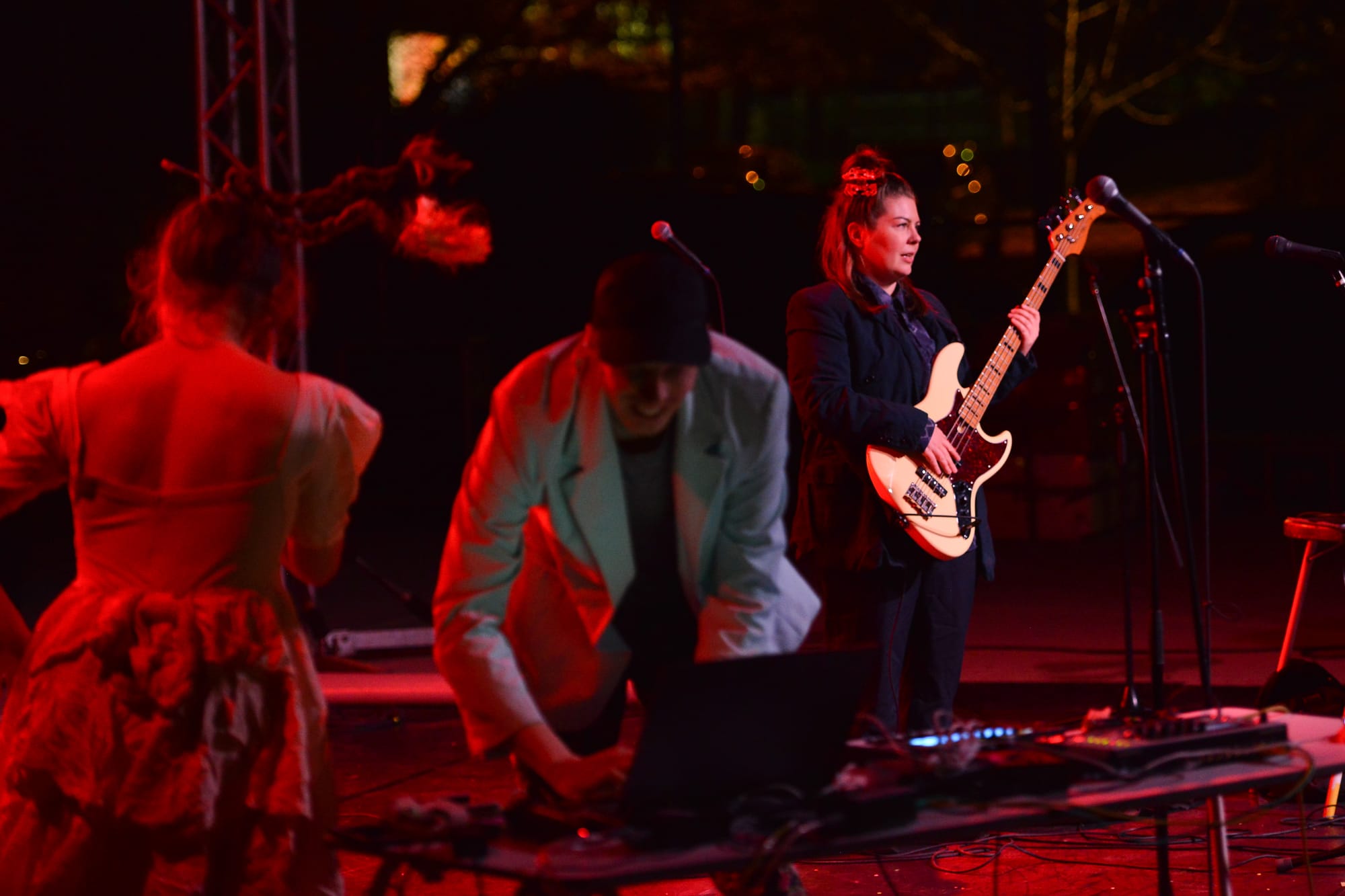
The night continues with a performance from Muovipussi. Blending rap, crispy pop and metal, they provide a rich repertoire of insanity according to the dominant social norms, out of which my favourite becomes the song about Finnish law, and the audio-circus moment where one of the artists juggles with poi made of the severed heads of baby dolls. Although the sung text remains foreign, other than the more universal words such as lobotomy, the Muovipussi-Kopilica encounter confirmed that the language of absurdity knows no borders. For the conclusion of this year's Peculiar families festival experience, your occasionally humble, extremely biased storyteller could not find better words than those which have already been said by the team behind the association Kopilica Split (KoST), from the neighborhood's engaged residents: "How nice it was to see at that moment the playground in Kopilica, which they wanted to raze to the ground and convert into a bus parking lot and which a few years ago was overgrown and empty, now colorful and filled with the noise of children's play and dance. For a moment, everything made sense."
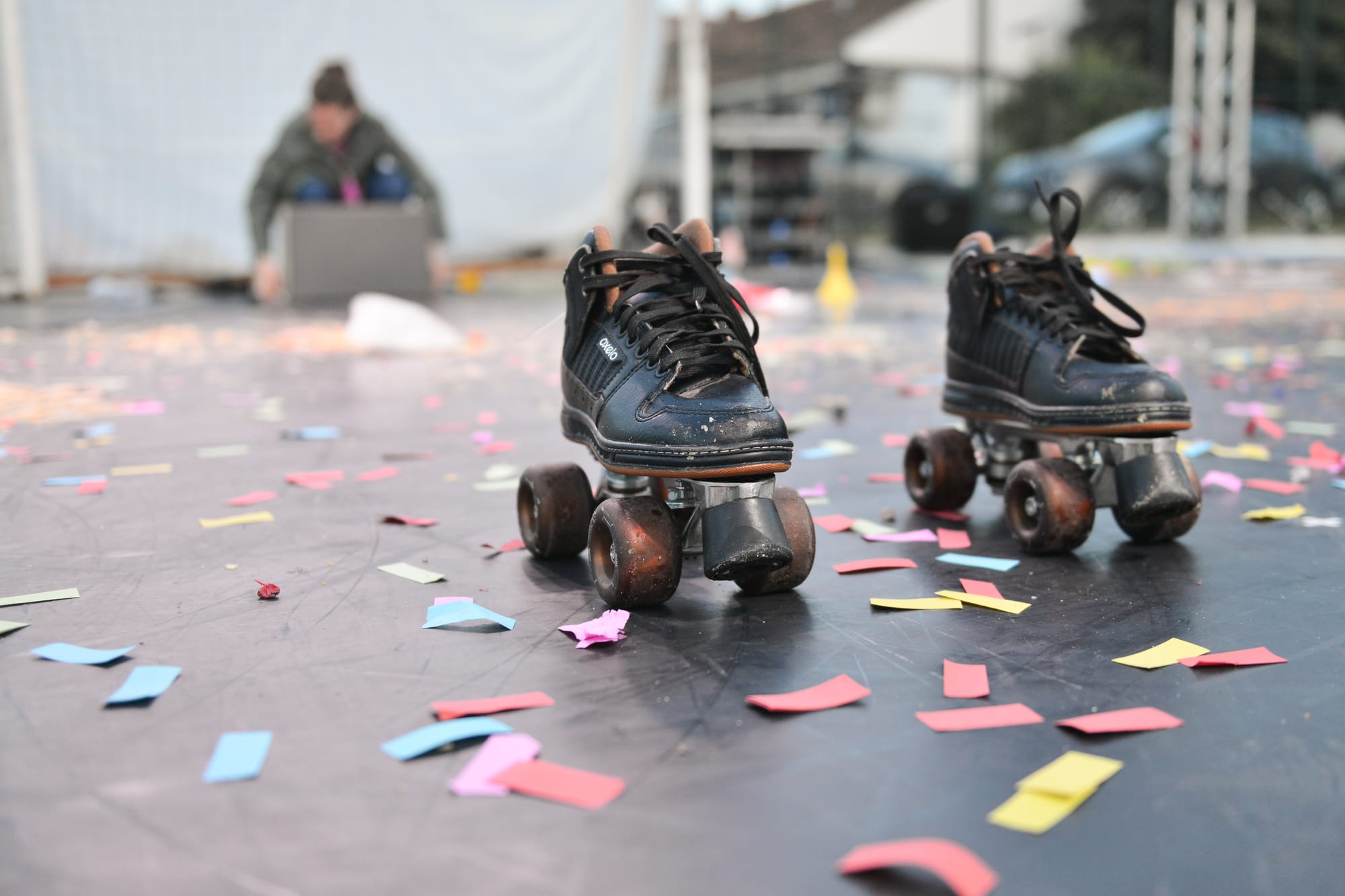
This review is published as one of the results of The Review Lab, a workshop held in Split by Around About Circus during the Peculiar Families Festival 2025 edition, thanks to DUSC and Room100.
To know more about the festival, read the review by Dora Komenda, Superheroes are dead. The Power of Circus Metaphors at Peculiar Families Festival 2025
